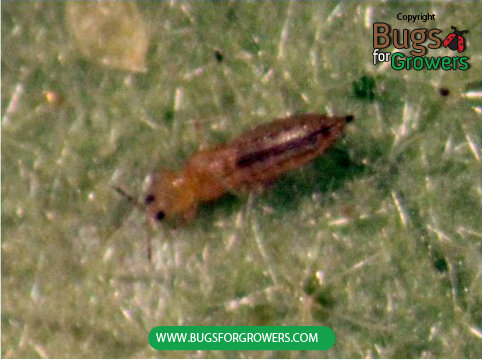What are the western flower thrips?
The western flower thrips (Scientific name: Frankliniella occidentalis) are tiny insects that cause significant damage to many ornamental (african violet, chrysanthemum, dahlia, gerbera, geranium, gladiolus, impatiens, ivy, orchids, roses etc.) and vegetable (cucumber, green/Sweet pepper, eggplants, onions, peas, tomatoes etc.) crops.
Damage by the western flower thrips
All species of thrips use their rasping and sucking types of mouthparts to scrape off the surface of the leaves and suck up the fluids from the top layer of cells until all the green tissue has been consumed, leaving silvery- gray patches on leaves. Thrips generally prefer to feed on succulent plant parts like flower and leaf buds. Heavy infestation of the western flower thrips can significantly reduce plant vigor due to loss of chlorophyll that in turn can reduce crop yields and aesthetic values of ornamental plants. The western flower thrips are also known to transmit plant viruses like Tomato spotted wilt virus and Impatiens necrotic spot virus.
Life cycle of the western flower thrips
The western flower thrips generally develop four developmental stages including eggs, larvae, pupae and adults. Females of the western flower thrips use their ovipositor to lay eggs inside the tissues of soft plant plants like leaf and flower buds. These eggs hatch into small, whitish to yellowish colored larvae (nymph) with large head capsules and red eyes (Photo 1). Young larvae then start feeding on soft plant tissues with their rasping and sucking types of mouthparts. Thrip larvae develop through two different stages and then turn into non- feeding pre-pupal and pupal stages. Pupae of western flower thrips generally live in the soil/ potting medium.
Photo 1. A larva of Thrip
Biological control of the western flower thrips
Beneficial predatory Stratiolaelaps scimitus (Hypoaspis miles) mites are considered as excellent biological agents to target and kill the soil-dwelling pupae of the western flower thrips that present in the soil.
What are beneficial predatory Stratiolaelaps scimitus mites?
Beneficial predatory Stratiolaelaps scimitus mites that are commercially available as a mixture of eggs, nymphs and adults that are currently used for controlling the western flower thrips infesting different crops grown in the greenhouses.
Adults of Stratiolaelaps scimitus mites are clear-brown to tan in color. Female mites lay oval shaped eggs in the soil/potting mix. These eggs hatch into tiny larvae that develop through two successive protonymphal and deutonymphal developmental stages. Larvae resemble their parents. The optimum temperature and relative humidity required for the reproduction, development and completion of the life cycle of Stratiolaelaps scimitus mites is between 15 and 25°C (59 and 77°F) and 40 and 60%, respectively.
How do Stratiolaelaps scimitus mites control thrips?
Immediately after the release of both the adults and nymphs of Stratiolaelaps scimitus mites in the greenhouses, they will quickly disperse themselves throughout the soil/media profile and seek the pupae of the western flower thrips and start feeding on them this in turn can reduce their populations below economic threshold level.
When is the best time to release Stratiolaelaps scimitus mites?
The best time to release Stratiolaelaps scimitus mites is when the surrounding temperature is between 15-25°C (59-77°F) with the relative humidity is between 40-60%. These mites can be used as preventive and curative control measures when there is a very low and high levels of populations of thrips present in the greenhouses, respectively.
How many Stratiolaelaps scimitus mites should be released for the control of thrips?
For the effective control of the western flower thrips, release 5000- 1000 Stratiolaelaps scimitusmites per 1000 square foot area depending on the level of fungus gnat infestation.
